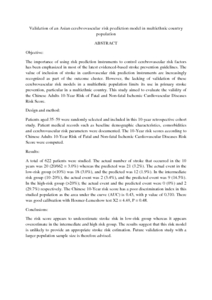Citation
Hoo, Fan Kee and Ching, Siew Mooi and Chia, Y.C.
(2015)
Validation of an Asian cerebrovascular risk prediction model in multiethnic country population.
Journal of Hypertension, 33.
p. 443.
ISSN 0263-6352; ESSN: 1473-5598
Abstract
Objective:
The importance of using risk prediction instruments to control cerebrovascular risk factors has been emphasized in most of the latest evidenced-based stroke prevention guidelines. The value of inclusion of stroke in cardiovascular risk prediction instruments are increasingly recognized as part of the outcome cluster. However, the lacking of validation of these cerebrovascular risk models in a multiethnic population limits its use in primary stroke prevention, particular in a multiethnic country. This study aimed to evaluate the validity of the Chinese Adults 10-Year Risk of Fatal and Non-fatal Ischemic Cardiovascular Diseases Risk Score.
Design and method:
Patients aged 35–59 were randomly selected and included in this 10-year retrospective cohort study. Patient medical records such as baseline demographic characteristics, comorbidities and cerebrovascular risk parameters were documented. The 10-Year risk scores according to Chinese Adults 10-Year Risk of Fatal and Non-fatal Ischemic Cardiovascular Diseases Risk Score were computed.
Results:
A total of 622 patients were studied. The actual number of stroke that occurred in the 10 years was 20 (20/662 = 3.0%) whereas the predicted was 21 (3.2%). The actual event in the low-risk group (<10%) was 18 (3.0%), and the predicted was 12 (1.9%). In the intermediate risk group (10–20%), the actual event was 2 (3.4%), and the predicted event was 9 (14.5%). In the high-risk group (>20%); the actual event and the predicted event were 0 (0%) and 2 (29.7%) respectively. The Chinese 10-Year risk score has a poor discrimination index in this studied population as the area under the curve (AUC) is 0.43, with p value of 0.310. There was good calibration with Hosmer-Lemeshow test X2 = 4.48, P = 0.48.
Conclusions:
The risk score appears to underestimate stroke risk in low-risk group whereas it appears overestimate in the intermediate and high risk group. The results suggest that this risk model is unlikely to provide an appropriate stroke risk estimation. Future validation study with a larger population sample size is therefore advised.
Download File
![[img]](http://psasir.upm.edu.my/46849/1.hassmallThumbnailVersion/Validation%20of%20an%20Asian%20cerebrovascular%20risk%20prediction%20model%20in%20multiethnic%20country%20population.pdf)  Preview |
|
PDF (Abstract)
Validation of an Asian cerebrovascular risk prediction model in multiethnic country population.pdf
Download (76kB)
| Preview
|
|
Additional Metadata
Actions (login required)
 |
View Item |

